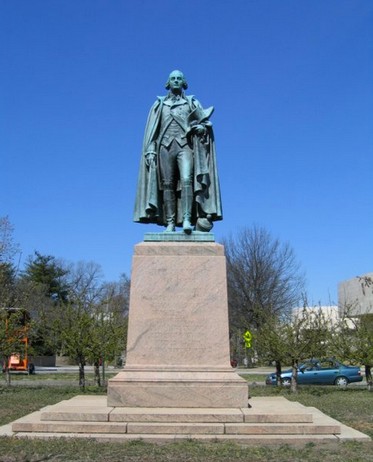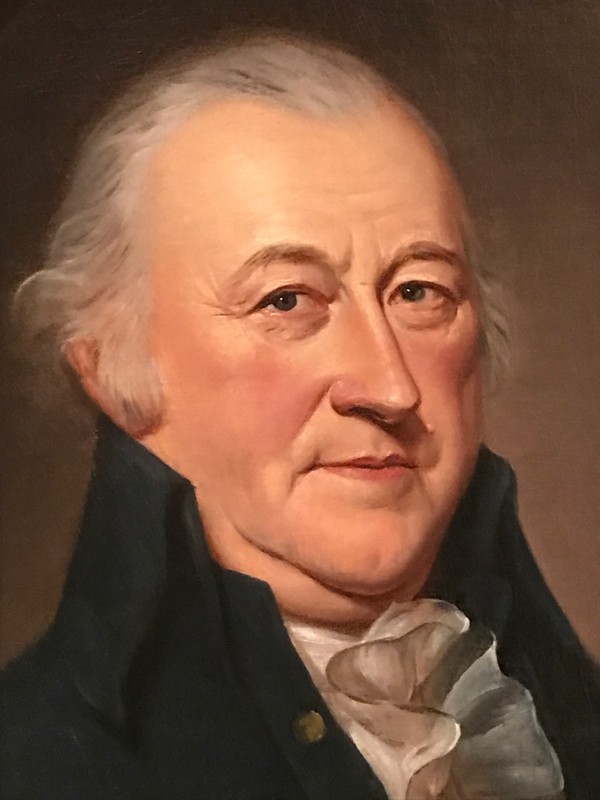General Artemas Ward Memorial
Introduction
Text-to-speech Audio
Images
General Artemas Ward Memorial in Ward Circle in Washington, D.C.

A closer look at the bronzer sculpture by Leonard Crunelle
.jpg)
A zoomed-in version of the portrait of Ward by Charles Wilson Peale that provided the inspiration for Crunelle's work

Backstory and Context
Text-to-speech Audio
Artemas Ward was born into a family of old puritan stock on November 26, 1727 in the town of Shrewsbury in what is now Worchester County, Massachusetts. Growing up, he attended common schools and received instruction from a private tutor. After graduating from Harvard College in 1748, Ward became a schoolteacher in Groton, Massachusetts. While living and working there, he met Sarah Trowbridge, the daughter of the Reverend Caleb Trowbridge. The couple wed in 1750 and then settled in Ward’s hometown of Shrewsbury, where he managed a farm and general store. The marriage ultimately produced eight children.
In the 1750s, Ward embarked on a lengthy career of public service. In 1751, he became a township accessor for Worchester County. The following year, Ward was elected a justice of the peace, in addition to the first of many terms in the Massachusetts General Court (colonial assembly). During the French and Indian War, he received a commission as a major in a provincial regiment. Ward eventually rose to the rank of lieutenant colonel and participated in British General James Abercrombie’s failed assault on Fort Carillon (later renamed Fort Ticonderoga). After his service, he returned to Shrewsbury and was appointed a judge on the Court of Common Pleas of Worcester County in 1762.
As tensions between the colonists of Massachusetts and Great Britain reached a boiling point in the wake of the passage of the Coercive Acts (known from the American perspective as the Intolerable Acts) in 1774, members of the dissolved General Court created the Massachusetts Provisional Assembly. That same year, the governing body commissioned Ward a brigadier general, and the following year made him commander-in-chief of all Massachusetts forces. About a month later, in June 1775, the Continental Congress commissioned him a major general in the Continental Army, making him second in command only to George Washington. Ward took command of the American forces besieging Boston and oversaw American defensive preparations in the lead up to the Battle of Bunker Hill. On July 2, Washington arrived in Cambridge and took over command. He did not think highly of Ward and criticized him both privately and publicly. Consequently, bad blood developed and relations between the two American commanders never improved.
After British forces evacuated Boston in March 1776, Ward returned to the law and politics. That year, he became chief justice of the Court of Common Pleas of Worchester County. Ward occupied the position until 1777, when he became president of the Massachusetts Executive Council, effectively operating as the colony’s chief executive for two years during the war. From 1780 to 1781, he held a seat in the Continental Congress, and later served two terms as a Federalist in the U.S. Congress from 1791 to 1795. Ward died on October 28, 1800 at the age of seventy-two. His remains were buried at Mountain View Cemetery in Shrewsbury.
In May 1931, Ward’s great-grandson, George Artemas Ward, struck an agreement with Harvard University that would help celebrate and perpetuate his ancestor’s memory. In exchange for donating his great-grandfather’s homestead in Shrewsbury and $4 million to the school, Ward mandated that Harvard erect a memorial in honor of his great-grandfather. To uphold its end of the deal, the university commissioned Chicago-based sculptor Leonard Crunelle to design and create the memorial. Dedicated on November 3, 1938 in a newly constructed traffic circle at the intersection of Nebraska Avenue and Massachusetts Avenue in Washington, D.C., the memorial consists of a ten-foot-tall bronze sculpture of Ward on a granite pedestal of equal height. Taking inspiration from a painting of the Revolutionary War general by Charles Wilson Peale, Crunelle depicted Ward standing in full military garb, scanning the horizon. With his left leg slightly ahead of his right, he cradles his hat in his left arm, clutches a pair of gloves with his left hand, and grasps his cape with his right.
Sources
"Artemas Ward Statue." historicsites.dcpreservation.org. DC Preservation League. Web. 18 April 2021 <https://historicsites.dcpreservation.org/items/show/641>.
"General Artemas Ward Memorial." NPS.gov. U.S. Department of the Interior. 7 February 2021. Web. 18 April 2021 <https://www.nps.gov/places/000/general-artemas-ward-memorial.htm>.
"General Ward." wardhouse.harvard.edu. General Artemas Ward House Museum. Harvard University. Web. 18 April 2021 <https://wardhouse.harvard.edu/general-ward>.
"Major General Artemas Ward." masshist.org. Massachusetts Historical Society. Web. 18 April 2021 <https://www.masshist.org/database/3451?ft=Revolutionary-Era%20Art%20and%20Artifacts&from=/features/revolutionary-era/people&noalt=1&pid=38>.
"Ward, Artemas." Biographical Directory of the United States Congress. United States Congress. Web. 18 April 2021 <https://bioguide.congress.gov/search/bio/W000127>.
https://www.tonydepaul.net/all-hail-bugs-in-the-beans/
https://en.wikipedia.org/wiki/Statue_of_Artemas_Ward
https://researchingtheamericanrevolution.com/major-generals/artemus-ward/
